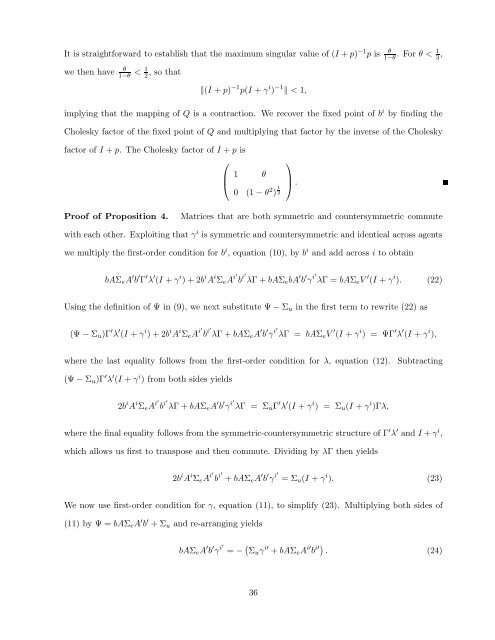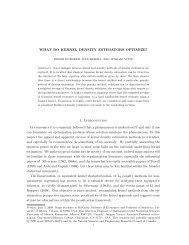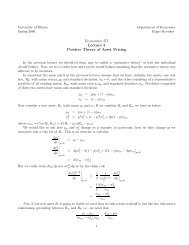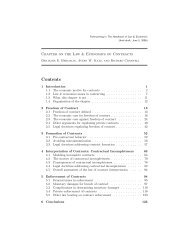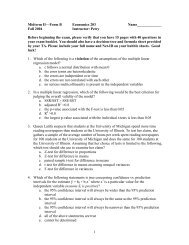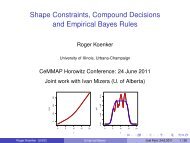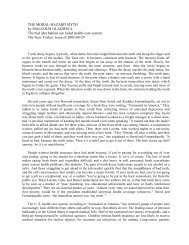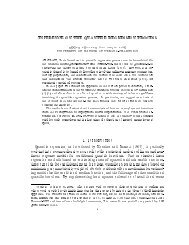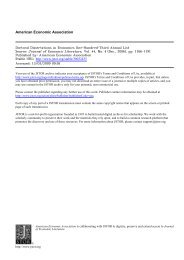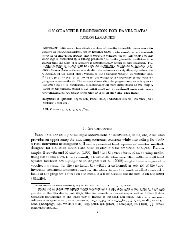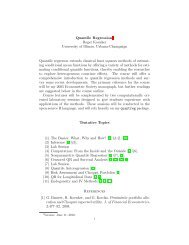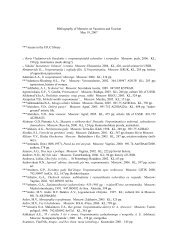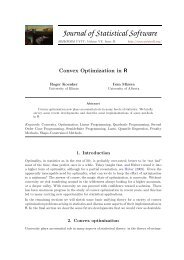Cross-Asset Speculation in Stock Markets∗ - Econometrics at Illinois ...
Cross-Asset Speculation in Stock Markets∗ - Econometrics at Illinois ...
Cross-Asset Speculation in Stock Markets∗ - Econometrics at Illinois ...
Create successful ePaper yourself
Turn your PDF publications into a flip-book with our unique Google optimized e-Paper software.
It is straightforward to establish th<strong>at</strong> the maximum s<strong>in</strong>gular value of (I + p) −1 p isθ1−θ . For θ < 1 3 ,we then haveθ1−θ < 1 2 , so th<strong>at</strong> ‖(I + p) −1 p(I + γ i ) −1 ‖ < 1,imply<strong>in</strong>g th<strong>at</strong> the mapp<strong>in</strong>g of Q is a contraction. We recover the fixed po<strong>in</strong>t of b i by f<strong>in</strong>d<strong>in</strong>g theCholesky factor of the fixed po<strong>in</strong>t of Q and multiply<strong>in</strong>g th<strong>at</strong> factor by the <strong>in</strong>verse of the Choleskyfactor of I + p. The Cholesky factor of I + p is⎛⎜⎝ 1θ0 (1 − θ 2 ) 1 2⎞⎟⎠ .Proof of Proposition 4.M<strong>at</strong>rices th<strong>at</strong> are both symmetric and countersymmetric commutewith each other. Exploit<strong>in</strong>g th<strong>at</strong> γ i is symmetric and countersymmetric and identical across agentswe multiply the first-order condition for b i , equ<strong>at</strong>ion (10), by b i and add across i to obta<strong>in</strong>bAΣ e A ′ b ′ Γ ′ λ ′ (I + γ i ) + 2b i A i Σ e A i′ b i′ λΓ + bAΣ e bA ′ b ′ γ i′ λΓ = bAΣ e V ′ (I + γ i ). (22)Us<strong>in</strong>g the def<strong>in</strong>ition of Ψ <strong>in</strong> (9), we next substitute Ψ − Σ u <strong>in</strong> the first term to rewrite (22) as(Ψ − Σ u )Γ ′ λ ′ (I + γ i ) + 2b i A i Σ e A i′ b i′ λΓ + bAΣ e A ′ b ′ γ i′ λΓ = bAΣ e V ′ (I + γ i ) = ΨΓ ′ λ ′ (I + γ i ),where the last equality follows from the first-order condition for λ, equ<strong>at</strong>ion (12). Subtract<strong>in</strong>g(Ψ − Σ u )Γ ′ λ ′ (I + γ i ) from both sides yields2b i A i Σ e A i′ b i′ λΓ + bAΣ e A ′ b ′ γ i′ λΓ = Σ u Γ ′ λ ′ (I + γ i ) = Σ u (I + γ i )Γλ,where the f<strong>in</strong>al equality follows from the symmetric-countersymmetric structure of Γ ′ λ ′ and I + γ i ,which allows us first to transpose and then commute. Divid<strong>in</strong>g by λΓ then yields2b i A i Σ e A i′ b i′ + bAΣ e A ′ b ′ γ i′ = Σ u (I + γ i ). (23)We now use first-order condition for γ, equ<strong>at</strong>ion (11), to simplify (23). Multiply<strong>in</strong>g both sides of(11) by Ψ = bAΣ e A ′ b ′ + Σ u and re-arrang<strong>in</strong>g yieldsbAΣ e A ′ b ′ γ i′ = − ( Σ u γ i′ + bAΣ e A i′ b i′) . (24)36


